
Lushpin-Landscape-City-Quebec-Province-Canada-Christmas-Night-Painting-Widescreen-Resolutions
Gene Autry - Rudolph the Red Nosed Reindeer
-----------------
Christmas traditions in Canada
Traditionally, Christmas celebrates the Nativity of Jesus
Christ. It was only in the fourth century, however, that December 25 was
chosen to celebrate Christmas as a substitute for the pagan feasts
celebrating the Winter Solstice. In the 5th century, under Pope Gregory
the Great, midnight mass was already being celebrated; by the 7th
century the custom of celebrating three masses had appeared.
Christmas celebrations spread across Europe in the early Middle Ages, reaching Ireland in the 5th century, England in the 7th century, Germany in the 8th century, Scandinavia in the 9th century and the Slavonic countries between the 9th and 11th centuries. The first crèches appeared in Italian churches in the 15th century. By the 17th century these were widespread.
Early in its history Christmas was an embattled holiday in England and America, distrusted by the Puritanical Protestant churches which saw it as a Catholic invention out of keeping with true Christian practice. Following the Parliamentary victory in the English Civil War the Puritans banned Christmas celebrations in England, provoking riots by the holiday’s supporters. Similar bans came into effect in parts of New England.
In Catholic New France, however, Christmas was condoned by the Church and enjoyed particular sentimental and spiritual importance among the early settlers and missionaries. Télésphore St. Pierre’s Histoire des Canadiens du Michigan et du comté d'Essex, Ontario offers a brief account of an early Christmas celebration in the Great Lakes region of New France (present-day Michigan) in 1675:

Christmas in French Canada has traditionally revolved around the veillée de Noël and réveillon: after the Christmas midnight mass, family members gathered together to share a large dinner with turkey, meat pies and other dishes, usually including the buche de Noël or Chistmas log for desert.
This illustration from Library and Archives Canada depicts a French Canadian village returning home after the midnight mass:

The Canadian Agricultural Library collection, accessible through the Canadiana Discovery Portal, includes transcripts to a series of weekly radio broadcasts from the 1930s. On December 13, 1934, the Dominion Department of Agriculture aired a show promoting the Christmas Turkey and declared: “To most Canadians, a Christmas dinner without a turkey would hardly be a Christmas dinner at all. A real Canadian graded turkey, when dressed, stuffed, and roasted to a rich brown will assist considerably in radiating the joyous spirit of Christmas and result in such a feeling of satisfaction after dinner that this will elude expression in mere words.”


Charles Dickens’ A Christmas Carol (1843) helped to reinvent Christmas as a popular seasonal holiday and inspired much Christmas-themed fiction. Contes de Noël is a book of tales written by Joséphine Marchand-Dandurand and published in Montreal in 1889 with a preface by renowned poet Louis Fréchette. Madame Dandurand was herself well known in the 19th century for her writing advocating women’s rights.

Many early Canadian periodicals offered their readers special illustrated Christmas supplements such as these published by the Northern Messenger in 1889 and the Dominion Illustrated in 1891:



Christmas trees have been traced back to 1521 in Alsace, but it was only in 1781 and the American Revolutionary War that this German tradition found its way to Canada. The first Canadian Christmas tree was set up in Sorel, Quebec by the wife of General von Reidesel, commander of a British garrison in Canada which included many German soldiers. However, the practice did not enter Canadian custom until the Victorian Age when it spread to the rest of Canada and the United States, but mainly within higher society families. It was only during the 1920s that Christmas trees began to appear in urban homes, then in country homes in the 1930s.
The Christmas tree in this 1878 Illustrated News image is adorned with toy soldiers and drums and appears to be crowned with the Canadian Red Ensign flag:

In a 19th century whose sensitivity to social and economic misfortune was rudimentary at best – the poor were expected to better their lot through thrift and hard work – Christmas promoted a rare message of charity towards the less fortunate. L’Opinion publique of December 31, 1874 contrasts the different realities of Christmas for the rich and the poor:

By the late 19th century the Christmas season had taken on the tremendous commercial and economic importance it continues, for better or worse, to enjoy to this day. This December 23, 1876 Canadian Illustrated News article depicts an upper-class home decorated with garlands on Christmas Eve:

Santa Claus is a folkloric figure of Germanic origin whose modern image as a gift-giving Christmas personality dates back to the 19th century. The most influential representation of Santa Claus was an 1863 illustration by Thomas Nast for Harper’s Weekly whose depiction of a jolly, bearded old man found echoes with many Canadian illustrators.
On this 1875 Christmas Day Canadian Illustrated News cover, the traditional British “Father Christmas” figure appears with all the trappings of the modern Santa Claus – right down to reindeer-drawn sleigh!

Scholars have debated the connection between Santa Claus and his Dutch predecessor, Sinterklaas or Saint Nicholas, who presides over the Feast of Saint Nicholas in Dutch tradition. The two figures are treated interchangeably in the Illustrated News of December 23, 1878:

This 1885 illustration depicts Santa Claus on a rare clean-shaven day:

By 1889 Santa is truly “the children’s friend” as he fulfills his familiar mission:


By the late 19th century, advances in cartography and communications allowed Canadian children to track Santa’s movements with a great degree of precision. In “The Triumph of Science” (Le Samedi), young Tommie explains: "I sure know my geography! You see, when Santa has nothing to do he retires to the North Pole. Several days before Christmas, he takes this route; there, you see it? Then he goes to Notre-Dame church to report to the Baby Jesus during the midnight mass and, on New Year's Eve, he'll bring us all the presents the Baby Jesus said!"

The Canadiana Discovery Portal contains several audio clip records including the two traditional French Canadian hymns below:
Noël des bergers (1920?) is sung by Joseph Saucier, who is believed to be the first French-Canadian artist to make a recording in Canada (circa 1904).
If you prefer something a bit more light-hearted, you might enjoy Noël tout blanc (1940?) by José Lasalle. Lasalle was the stage name of Roland Lebrun, better known in Quebec as "soldat Lebrun." Though perhaps forgotten today, he was extremely popular in Quebec in the early 1940s.
---------------------
Christmas celebrations spread across Europe in the early Middle Ages, reaching Ireland in the 5th century, England in the 7th century, Germany in the 8th century, Scandinavia in the 9th century and the Slavonic countries between the 9th and 11th centuries. The first crèches appeared in Italian churches in the 15th century. By the 17th century these were widespread.
Early in its history Christmas was an embattled holiday in England and America, distrusted by the Puritanical Protestant churches which saw it as a Catholic invention out of keeping with true Christian practice. Following the Parliamentary victory in the English Civil War the Puritans banned Christmas celebrations in England, provoking riots by the holiday’s supporters. Similar bans came into effect in parts of New England.
In Catholic New France, however, Christmas was condoned by the Church and enjoyed particular sentimental and spiritual importance among the early settlers and missionaries. Télésphore St. Pierre’s Histoire des Canadiens du Michigan et du comté d'Essex, Ontario offers a brief account of an early Christmas celebration in the Great Lakes region of New France (present-day Michigan) in 1675:

Christmas in French Canada has traditionally revolved around the veillée de Noël and réveillon: after the Christmas midnight mass, family members gathered together to share a large dinner with turkey, meat pies and other dishes, usually including the buche de Noël or Chistmas log for desert.
This illustration from Library and Archives Canada depicts a French Canadian village returning home after the midnight mass:

The Canadian Agricultural Library collection, accessible through the Canadiana Discovery Portal, includes transcripts to a series of weekly radio broadcasts from the 1930s. On December 13, 1934, the Dominion Department of Agriculture aired a show promoting the Christmas Turkey and declared: “To most Canadians, a Christmas dinner without a turkey would hardly be a Christmas dinner at all. A real Canadian graded turkey, when dressed, stuffed, and roasted to a rich brown will assist considerably in radiating the joyous spirit of Christmas and result in such a feeling of satisfaction after dinner that this will elude expression in mere words.”


Charles Dickens’ A Christmas Carol (1843) helped to reinvent Christmas as a popular seasonal holiday and inspired much Christmas-themed fiction. Contes de Noël is a book of tales written by Joséphine Marchand-Dandurand and published in Montreal in 1889 with a preface by renowned poet Louis Fréchette. Madame Dandurand was herself well known in the 19th century for her writing advocating women’s rights.

Many early Canadian periodicals offered their readers special illustrated Christmas supplements such as these published by the Northern Messenger in 1889 and the Dominion Illustrated in 1891:


Christmas trees have been traced back to 1521 in Alsace, but it was only in 1781 and the American Revolutionary War that this German tradition found its way to Canada. The first Canadian Christmas tree was set up in Sorel, Quebec by the wife of General von Reidesel, commander of a British garrison in Canada which included many German soldiers. However, the practice did not enter Canadian custom until the Victorian Age when it spread to the rest of Canada and the United States, but mainly within higher society families. It was only during the 1920s that Christmas trees began to appear in urban homes, then in country homes in the 1930s.
The Christmas tree in this 1878 Illustrated News image is adorned with toy soldiers and drums and appears to be crowned with the Canadian Red Ensign flag:

In a 19th century whose sensitivity to social and economic misfortune was rudimentary at best – the poor were expected to better their lot through thrift and hard work – Christmas promoted a rare message of charity towards the less fortunate. L’Opinion publique of December 31, 1874 contrasts the different realities of Christmas for the rich and the poor:

By the late 19th century the Christmas season had taken on the tremendous commercial and economic importance it continues, for better or worse, to enjoy to this day. This December 23, 1876 Canadian Illustrated News article depicts an upper-class home decorated with garlands on Christmas Eve:

Santa Claus is a folkloric figure of Germanic origin whose modern image as a gift-giving Christmas personality dates back to the 19th century. The most influential representation of Santa Claus was an 1863 illustration by Thomas Nast for Harper’s Weekly whose depiction of a jolly, bearded old man found echoes with many Canadian illustrators.
On this 1875 Christmas Day Canadian Illustrated News cover, the traditional British “Father Christmas” figure appears with all the trappings of the modern Santa Claus – right down to reindeer-drawn sleigh!

Scholars have debated the connection between Santa Claus and his Dutch predecessor, Sinterklaas or Saint Nicholas, who presides over the Feast of Saint Nicholas in Dutch tradition. The two figures are treated interchangeably in the Illustrated News of December 23, 1878:

This 1885 illustration depicts Santa Claus on a rare clean-shaven day:

By 1889 Santa is truly “the children’s friend” as he fulfills his familiar mission:


By the late 19th century, advances in cartography and communications allowed Canadian children to track Santa’s movements with a great degree of precision. In “The Triumph of Science” (Le Samedi), young Tommie explains: "I sure know my geography! You see, when Santa has nothing to do he retires to the North Pole. Several days before Christmas, he takes this route; there, you see it? Then he goes to Notre-Dame church to report to the Baby Jesus during the midnight mass and, on New Year's Eve, he'll bring us all the presents the Baby Jesus said!"

The Canadiana Discovery Portal contains several audio clip records including the two traditional French Canadian hymns below:
Noël des bergers (1920?) is sung by Joseph Saucier, who is believed to be the first French-Canadian artist to make a recording in Canada (circa 1904).
If you prefer something a bit more light-hearted, you might enjoy Noël tout blanc (1940?) by José Lasalle. Lasalle was the stage name of Roland Lebrun, better known in Quebec as "soldat Lebrun." Though perhaps forgotten today, he was extremely popular in Quebec in the early 1940s.
http://www.canadiana.ca/en/Christmas-2011
---------------------
A Canadian Christmas Story
The reminiscences In this Canadian Christmas story are strikingly different from how Christmas is celebrated today. Times were simpler in the early 1800s, and the festivities were much less commercialized, yet so full of meaning and family and joy. Read and see.Reminiscences of Christmases Past
The Girl’s Own Annual (1891)
 Canadian Village Evening in the Early 1800s
Canadian Village Evening in the Early 1800sCanadian Christmas Story — Part I
Another Christmas, and the sun had just set in one of our small Canadian villages, leaving a trail of beautiful colors behind it on the usual gray-tinted sky of evening, and the one village street was just being lighted with its oil lamps, which burnt most dimly, and were at best few and far between. But though the lights were dim the hearts were light, for it was Christmas Eve.In the little wooden church, by the dim light of a few lanterns and an odd lamp, a number of young people were sticking here and there, in holes bored in the different seats, small branches of the mountain ash, with their scarlet berries, and two or three of the most venturesome spirits had gone so far as to put a few bits in the corners of the somber old pulpit. But much decoration was deemed unseemly, and not allowed in those primitive times.
In the vestry beyond were assembled the doctor's young son, a stalwart young butcher, and a short, bald-headed old man, who on ordinary days mended the villagers' boots and shoes, but who at this time was bringing forth the most doleful groans from a big bass viol in his efforts to keep time with the above-named young gentlemen, who were practicing their respective parts in the Psalms and hymn tunes on a flute and violin.
These, with a few young girls' voices, comprised the little choir; but tonight the young maidens were too busy to join them, and only peeped in as they passed to and fro bearing their little branches to their destination.
Canadian Christmas Story — Part II
In the little frame cottages the mothers were more or less busy preparing the good things for the week, for these kindly people laid in such a store of cakes and pies as would astonish ordinary mortals nowadays.There was the great stone oven to be heated for the dozen of pumpkin pies, and how recklessly the golden cream had been stirred in none but the good mother knew, for had she not a fine brindled cow of her own? And the pies must be extra good this Christmastime, when all the children would be coming home.
Then the turkey was well stuffed with savory herbs that she had picked and dried out of her own nice garden, the apple-cream placed in the big glass dish, and the Christmas pudding tied ready for the pot.
I was watching our good housewife as she went back and forth in her spotless kitchen, when suddenly I heard the light flying steps of children, and two young creatures, a boy of about five years of age and a little girl of seven, came in so covered with snow that but for their rosy cheeks and chattering tongues I should have taken them for two snow images.
They had been out with their sled, as they called it; and had tumbled from it so often in their sliding downhill that all their garments had a firm coating of the glistening snow.
As each laid aside comforter, cap, and hood, I saw that the boy had curly brown hair, but the girl's wavy locks were as fair as her face almost, and you could see that she had a sensitive, clinging nature, and I could not help wondering what her future might be.
Canadian Christmas Story — Part III
Well, the children sat themselves down by the great kitchen fire, where a pot hung on a long crook, or crane, full of boiling lard, waiting for the few remaining crullers to be dropped in it. A great platter of the crisp brown donuts was already on the table, which the children eyed so lovingly that their mother gave them each one, and, telling them to go to bed, said—"For you know, dears, that Christkindchen never comes to fill the stockings of the good little children till they are all asleep."
Then you should have seen the awe that stole into the little girl's face as she turned her fluffy head, and looking up into the broad chimney, said—
"Christkindchen! Christkindchen! We have been good; please put something nice into our stockings, but be very careful of the fire when you come down, or it will burn you."
And Christkindchen heard her and came carefully down, for in the morning both children's stockings were full. But, you little people nowadays, who have so many toys, picture books, and French sweets, and no end of valuable gifts besides, will laugh when I tell you what trifles gave those little ones of that household long ago so much pleasure.
First, in the toes of the little stockings were a few sticks of homemade candy, twisted tightly in paper, a package of blanched almonds, and raisins, and a dolly made of the doughnuts, with allspice eyes, cloves for ears and nose, and a raisin for the mouth; this was prized the most and carried about all day; and I saw tears shed when one was broken, though comfort was found afterwards in a degree by the eating of it.
—Remembrances of an Early Canadian Christmas by an Anglo Canadian in the early 1800s is curated from "The Girl's Own Annual" by Phyllis Browne et al, published by Pinn, London, in 1891.
About the Canadian Christmas Story
This Canadian Christmas story offers a true account of what it was like celebrating Christmas in Canada back in the early 1800s. Times were simpler yet in many ways happier and more relaxed. It reminds us all to slow down and savor the Holiday Season.Christmas was centered around its true meaning, the birth of Jesus Christ, and the love of one's family and friends. It was a time of great rejoicing, feasting, and fun. And in the midst of it all were delicious homemade desserts and treats made specially for Christmas Day.
Thankfully, historical recipes for the cakes, pumpkin pies, Christmas pudding, homemade donuts, and sticks of homemade candy mentioned in the story can all be found within the pages of this website.
Use the Christmas dessert recipes to give your children the experience of an old fashioned Christmas celebration. May you and yours have a very Merry Christmas, and peace and prosperity in the New Year!
-------------------------------------
20 Famous Christmas Stories
Over the years, Christmas has inspired many authors to write about its spirit and significance. The spirit that embodies charity, forgiveness, friendship, unselfish love and generosity. In the stories that follow, you will find many examples of what makes the Christmas Spirit so unique and special. Though most of these stories have been written for children, readers of all ages will enjoy these skillfully told tales.
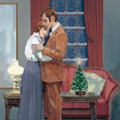
1. The Gift of the Magi – O. Henry
O. Henry was the pseudonym of the American writer William Sydney Porter (September 11, 1862 – June 5, 1910). O. Henry’s short stories are well known for their wit, wordplay, warm characterization and clever twist endings. The Gift of the Magi is one of O. Henry’s most famous stories. The story contains many of the elements for which O. Henry is widely known, including poor, working-class characters, a humorous tone, realistic detail, and a surprise ending. A major reason given for its enduring appeal is its affirmation of unselfish love. Such love, the story and its title suggest, is like the gifts given by the wise men, called the Magi, who brought gold, frankincense, and myrrh to the newborn Jesus.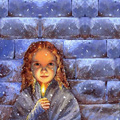
2. The Little Match Girl – Hans Christian Anderson
Hans Christian Andersen (April 2, 1805 – August 4, 1875) was a Danish author and poet noted for his children’s stories. During his lifetime he was acclaimed for having delighted children worldwide, and was feted by royalty. His poetry and stories have been translated into more than 150 languages. They have inspired motion pictures, plays, ballets, and animated films. Originally published as part of Andersen’s fifth volume of Fairy Tales in 1848, The Little Match Girl is an original Andersen story inspired by a Johan Thomas Lundbye drawing and loosely based on an incident that happened to Andersen’s mother when she was a child. Written nine years after Andersen’s friend and colleague Charles Dickens finished Oliver Twist, The Little Match Girl shed a light on a very oppressed and silent group in Europe — its children.
3. A Christmas Carol – Charles Dickens
A Christmas Carol is a novella by English author Charles Dickens first released on 19 December 1843. The story tells of sour and stingy Ebenezer Scrooge’s ideological, ethical, and emotional transformation after the supernatural visitations of Jacob Marley and the Ghosts of Christmases Past, Present, and Yet to Come. The novella met with instant success and critical acclaim. With A Christmas Carol, Dickens hoped to illustrate how self-serving, insensitive people can be converted into charitable, caring, and socially conscious members of society. With each Ghost’s tale functioning as a parable, A Christmas Carol advances the Christian moral ideals associated with Christmas—generosity, kindness, and universal love for your community.
4. A Letter From Santa Claus – Mark Twain
Samuel Langhorne Clemens (November 30, 1835 – April 21, 1910), well known by his pen name Mark Twain, was an American author and humorist. Twain is noted for his novels Adventures of Huckleberry Finn, which has been called “the Great American Novel”, and The Adventures of Tom Sawyer. Twain was a friend to presidents, artists, industrialists, and European royalty. His elder daughter, Suzy Clemens, was born in Elmira, New York, and lived a short life, dying at the age of 23 from meningitis. In childhood, Suzy often had poor health, similar to her mother. At 13, she wrote a biography of her father, which was included as par of Twain’s Chapters From My Autobiography. Mark Twain wrote a letter to his daughter, which he sent from Santa Claus, during one of her childhood illnesses.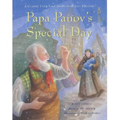
5. Papa Panov’s Special Christmas – Leo Tolstoy
Leo Tolstoy, or Count Lev Nikolayevich Tolstoy (September 9 1828 – November 20 1910), was a Russian writer widely regarded as among the greatest of novelists. Tolstoy’s further talents as essayist, dramatist, and educational reformer made him the most influential member of the aristocratic Tolstoy family. Papa Panov’s Special Christmas was originally written in French by Ruben Saillens, and then translated into English by Tolstoy. This is a very thoughtful story, based on the Bible text ‘I was hungry and you gave me food, I was thirsty and you gave me water’ which Jesus used to make us understand how we should serve him by serving each other. The story of Papa Panov is an excellent way to introduce young chldren to the principles of kindness.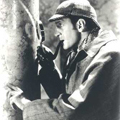
6. The Adventure of the Blue Carbuncle – Sir Arthur Conan Doyle
The Adventure of the Blue Carbuncle is one of the 56 short Sherlock Holmes stories written by British author Sir Arthur Conan Doyle (22 May 1859 – 7 July 1930), and is the seventh story of twelve in The Adventures of Sherlock Holmes. The story was first published in Strand Magazine in January 1892. The plot revolves around a rare blue carbuncle (a type of semi precious stone) going missing. Watson visits Holmes at Christmas time and finds him contemplating a battered old hat, brought to him by the commissionaire Peterson after the hat and a Christmas goose had been dropped by a man in a scuffle with some street ruffians. Peterson takes the goose home to eat it, but comes back later with the carbuncle. His wife has found it in the bird’s throat. Holmes cannot resist a good mystery, and he and Watson set out across the city to determine exactly how the stolen jewel wound up in a Christmas goose.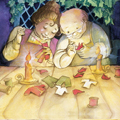
7. The Elves and the Shoemaker – Brothers Grimm
The Elves and the Shoemaker is part of a collection of German origin fairy tales first published in 1812 by Jacob and Wilhelm Grimm, the Brothers Grimm. The collection is commonly known today as Grimm’s Fairy Tales. The theme is a well-known one throughout European folklore. There are many warning stories about what should happen if the recipient of faerie help should offer clothes to his or her benefactor. According to the tales, pixies and faeries alike consider clothing to be a form of bondage, and see any kind offers or new clothes as a way to enslave the faerie.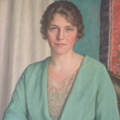
8. Christmas Day in the Morning – Pearl S. Buck
Originally published in 1955, Christmas Day in the Morning is a heartwarming story about sacrifice and the spirit of giving. Pearl S. Buck (June 26, 1892 — March 6, 1973) was an award-winning American writer who spent the majority of her life in China. Her novel The Good Earth won the Pulitzer Prize in 1932. In 1938, she became the first American woman to be awarded the Nobel Prize in Literature for her rich and truly epic descriptions of peasant life in China and for her biographical masterpieces. In Christmas Day in the Morning, Buck has captured the spirit of Christmas in this elegant, heartwarming story about a boy’s gift of love.
9. The Snowman – Raymond Briggs
The Snowman is a children’s book by English author Raymond Briggs (born 18 January 1934), published in 1978. In 1982, this book was turned into a 26-minute animated movie by Dianne Jackson. The film was nominated for the Academy Award for Animated Short Film in 1982. The book is wordless, as is the film except for the song "Walking in the Air”. The story is told through picture, action and music. A groundbreaking publication depicting the birth and development of a beautiful but fragile friendship between a young boy, James, and the Snowman he has built in his back garden.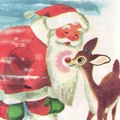
10. Rudolph the Red Nosed Reindeer – Robert L. May
Rudolph the Red-nosed Reindeer is a character created in a story and song by the same name. The story was created by Robert L. May in 1939 as part of his employment with Montgomery Ward. In its first year of publication, Montgomery Ward distributed 2.4 million copies of Rudolph’s story. Johnny Marks decided to adapt May’s story into a song, which through the years has been recorded by many artists. It was first sung commercially by crooner Harry Brannon on New York City radio in the latter part of 1948 before Gene Autry recorded it formally in 1949, and has since filtered into the popular consciousness.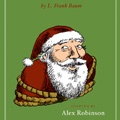
11. A Kidnapped Santa Claus – L. Frank Baum
Lyman Frank Baum (15 May 1856 – 6 May 1919) was an American author of children’s books, best known for writing The Wonderful Wizard of Oz. A Kidnapped Santa Claus is a Christmas-themed short story written by L. Frank Baum. It is a continuation of the story set forth in The Life and Adventures of Santa Claus, telling how Santa Claus was kidnapped by “Daemons” in a plan to make children unhappy. It has been called one of Baum’s most beautiful stories and constitutes an influential contribution to the mythology of Christmas.
12. The Holy Night – Selma Lagerlof
One cold winter’s night, a cruel and hard-hearted shepherd is amazed by some strange happenings. A man comes looking for wood for a fire to warm his wife and newborn baby, and following the man back to his cold grotto, the shepherd discovers the true spirit of Christmas. Selma Ottilia Lovisa Lagerlöf (20 November 1858–16 March 1940) was a Swedish author. She was the first female writer to win the Nobel Prize in Literature, and most widely known for her children’s book The Wonderful Adventures of Nils.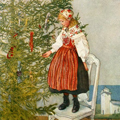
13. At Christmas Time – Anton Chekhov
Anton Pavlovich Chekhov (29 January 1860 – 15 July 1904) was a Russian short-story writer, playwright and physician, considered to be one of the greatest short-story writers in the history of world literature. As Chekhov wrote to a friend, “Medicine is my lawful wife, and literature is my mistress. When I get fed up with one, I spend the night with the other. Though it is irregular, it is less boring this way, and besides, neither of them loses anything through my infidelity.”
14. The Steadfast Tin Soldier – Hans Christian Anderson
The Steadfast Tin Soldier is a literary fairy tale by Hans Christian Andersen about a tin soldier and his love for a paper ballerina. The Steadfast Tin Soldier was the first tale Andersen wrote that had neither a literary model nor a folk tale source but is straight from Andersen’s imagination. It marked a new independence in his writing, and successfully brought to life the nineteenth century nursery world with its toy dancers, castles, and swans.
15. The Christmas Rose – Lizzie Deas
On a cold December night, everybody was coming to see their new Savior and brought Him all kinds of gifts and presents. A shepherd maiden had also come to see the Christ Child but she was very poor and had nothing to offer the child. She felt helpless and was quietly weeping outside the door. An angel took pity on her and gently brushed aside the snow at her feet, from where a beautiful cluster of waxen white winter roses sprang up with pink tipped petals. He softly whispered to her that these Christmas roses are more valuable than any myrrh, frankincense or gold for they are pure and made of love.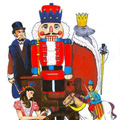
16. The Nutcracker and The Mouse King – E.T.A Hoffman
The Nutcracker and the Mouse King is a story written in 1816 by E. T. A. Hoffmann in which young Marie Stahlbaum’s favorite Christmas toy, the Nutcracker, comes alive and, after defeating the evil Mouse King in battle, whisks her away to a magical kingdom populated by dolls. In 1892, the Russian composer Pyotr Ilyich Tchaikovsky and choreographers Marius Petipa and Lev Ivanov turned the story into the ballet The Nutcracker, which became one of Tchaikovsky’s most famous compositions, and one of the most popular ballets in the world.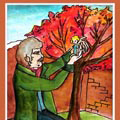
17. The Selfish Giant – Oscar Wilde
Oscar Fingal O’Flahertie Wills Wilde (16 October 1854 – 30 November 1900) was an Irish writer, poet, and prominent aesthete. He became one of the most successful playwrights of the late Victorian era in London with a series of social satires which continue to be performed, especially his masterpiece The Importance of Being Earnest. Oscar Wilde’s fairy tales have been dramatized, made into films, ballets, plays and adapted for radio. The Selfish Giant is a multi-layered short story that will appeal to both children and adults because of the depth of its meaning. For young children it can be read literally about a giant who is mean and whose garden refuses to grow. For older readers the religious symbolism can also be reflected upon as discussing themes such as selfishness and forgiveness. The meaning of the wall around the garden, symbolic of people shutting each other out can also be debated upon.
18. The Christmas Cuckoo – Frances Browne
Frances Browne (January 16, 1816 – 1879) was a blind Irish poet and novelist, best remembered for her collection of short stories for children: Granny’s Wonderful Chair, of which The Christmas Cuckoo is a part. It is a richly imaginative book of fairy stories and has been translated into many languages. In Granny’s Wonderful Chair there are seven stories, set in an interesting framework that tells of the adventures of the little girl Snowflower and her chair at the court of King Winwealth. From beginning to end it is filled with pictures; each little tale has its own picturesque setting, its own vividly realized scenery.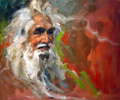
19. The Other Wise Man – Henry Van Dyke
Four Wise Men followed the star in the east, but only three arrived in Bethlehem on time. This is the legend of the fourth Wise Man Artaban and his journey in search of the King. Henry van Dyke (1852 – 1933) was an American author, educator, and clergyman. He graduated from Princeton University in 1873 and from Princeton Theological Seminary, 1877 and served as a professor of English literature at Princeton between 1899 and 1923. In 1908-09 Dr. van Dyke was an American lecturer at the University of Paris. By appointment of President Wilson he became Minister to the Netherlands and Luxembourg in 1913. He was elected to the American Academy of Arts and Letters and received many other honors.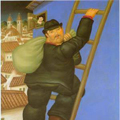
20. The Burglar’s Christmas – Willa Cather
The Burglar’s Christmas is a short story by Willa Cather. It was first published in Home Monthly in 1896 under the pseudonym of Elizabeth L. Seymour, her cousin’s name. Cather was celebrated by critics like H.L. Mencken for writing in plainspoken language about ordinary people. When novelist Sinclair Lewis won the Nobel Prize in Literature, he paid homage to her by saying that Cather should have won the honor.Spend a quiet and cozy evening with your loved ones and read these charming stories about Christmas. These stories are a great way for kids and adults to learn more about Christmas, its meaning and message, and why it is the most special holiday of the year.
----------------
Christmas in Canada
One of these festivals, the Roman solar
feast of Natalis Invicti, celebrated on 25 December, may have a strong
claim as the origin of our late December date for Christmas. This solar
cult reached its climax under Emperor Aurelian (270-275).
Christmas in Canada
While Christmas is generally defined as the Christian celebration of the birth of Jesus, the festival has complex origins and ambiguous non-religious resonances. The origin of the name Christmas is the Old English Crïstes mæsse, "Christ's mass." The French Noël derives from the Latin Dies Natalis, "Day of Birth."Why is Christmas on the 25th of December?
Whatever the origins of the festival that is held on the 25th of December, it cannot be the celebration of the actual birth date of Jesus. That date is unknown. So while Christmas is the day on which the birth of Jesus is celebrated, the day chosen seems more related to the many festivals that mark the winter solstice, most of which in Roman or Celtic times predate the birth of Jesus. While it cannot be said that these festivals are the origin of Christmas, they have left their legacy not only in the time of year, but also in many of its symbols and traditions. Winter solstice festivities of course celebrated renewal and the return of light, a perfect complement to the birth of Christ, which, according to the Christian faith, brought light into the world to dispel the darkness of sin and radiate the love of God. (In the Northern Hemisphere, the solstice occurs everywhere at the same time between 20 and 23 December, based on the Gregorian calendar, but local time may be on 21 December in Western Canada and 22 December in Eastern Canada.)The Pagan Antecedents to Christmas
Solstice festivals, marking the low point of the sun, the shortest day of the year, the time from which days will lengthen and hopes for light and warmth will reappear, have been celebrated perhaps for millennia in northern climates, where WINTERS are more severe.One of these festivals, the Roman solar feast of Natalis Invicti, celebrated on 25 December, may have a strong claim as the origin of our late December date for Christmas. This solar cult reached its climax under Emperor Aurelian (270-275). Later Christians, eg, Chrysostom in the 4th century, made a connection of this festival with the birth of Jesus: "if they say that it is the birthday of the Sun, He is the Sun of Justice."
Also in Roman times, Saturnus, the god of seed and sowing, was honored with a festival. The Saturnalia was officially celebrated on 17 December and, in Cicero's time, lasted seven days, from 17-23 December. In the Roman calendar, the Saturnalia was designated a holy day, on which religious rites were performed. But it was also the most popular holiday of the Roman year, an occasion for visits to friends, for drinking, and for the presentation of gifts, particularly wax candles, perhaps to signify the return of light after the solstice. The Saturnalia continued to be celebrated down to the Christian era, when, by the middle of the fourth century AD, its festivities had become absorbed in the celebration of Christmas.
In North America, some FIRST NATIONS also held winter ceremonies and festivals as a time for regeneration and introspection. Some, such as the Iroquoian groups, held week-long festivals at mid-winter, with the time determined by observing the moon and stars. It eventually came to be associated with the winter solstice. Typical practices, some of which continue to this day, were healing rituals, making tobacco offerings, prayer and ceremonial drumming and dancing.
Early Christian Dates for Christmas
Some of the earliest records for the celebration of the birth of Jesus come from Alexandria, Egypt. Several scholars, dating back to Clement of Alexandria (c. 200 AD), have attempted to determine the exact date of Jesus' birth. The date has yet to be determined, but Clement notes that Epiphany and the Nativity were celebrated on 10 or 6 January, indicating that some sort of consensus was reached. The commemorations became popular in Egypt between 427 and 433. At the end of the fourth century, in Cyprus Epiphanius asserts that Jesus was born on 6 January and baptized on 8 November.In Jerusalem in the fourth century the Birth and Baptism were still combined in a single event. There is a record of Cyril of Jerusalem (348-386) writing to Pope Julius I (337-352), declaring that his clergy cannot, on this single feast, make a double procession to Bethlehem and Jordan. He asks Julius to assign the true date of the nativity based on the census documents brought by Titus to Rome, and Julius assigns 25 December. But Julius died in 352, and by 385 Cyril still had not made the change.
Hence there were precedents when Pope Liberius I (reigned 353-356) preached a sermon at St. Peter's, instituting the Nativity feast in December. By the end of the fourth century the feast was established, and every Western calendar assigned it to 25 December. The new date reached Constantinople by 379. In the Western church, Epiphany is usually celebrated as the time the Magi, or Wise Men, arrived to present gifts to the young Jesus (Matt. 2:1-12). Epiphany, also called Twelfth Day, is typically celebrated on 6 January, culminating the observance of Twelfth Night on 5 January. Since Eastern Orthodox traditions use a different religious calendar, they celebrate Christmas on 7 January and observe Epiphany, or Theophany, on 19 January.
The Second Council of Tours proclaimed, in 566 or 567, the sanctity of the "twelve days" from Christmas to Epiphany and the duty of fasting on particular days of Advent (period beginning on the Sunday nearest the feast of St. Andrew, on 30 November, and including four Sundays) to prepare for the celebration of Jesus' birth. Fasting was forbidden on Christmas Day and eventually popular merry-making so overwhelmed the religious aspects that the "Laws of King Cnut," c. 1110, ordered a fast from Christmas to Epiphany.
Christmas Tree
The Christmas tree, along with the Nativity scene is the chief physical symbol of Christmas across Canada in homes, businesses and public spaces. The tree is a symbol of evergreen, of life, of magical powers in deepest winter. Varieties of evergreen boughs adorned homes and temples during solstice festivals across the Roman Empire. Pagan German tribes as well set up fir trees in their homes to welcome the domestic goddess of home and hearth. Evergreens as a strong symbol of eternal life and longevity acquired a parallel symbolism with the feast of Christmas, despite the futile attempts of the Christian Church to ban their use.Historical evidence for the decoration of trees at Christmas dates from Riga, Latvia (1510) on Christmas Eve. Descriptions of German Christmas trees date to 1531 in Alsace and 1605 in Strasbourg, where the firs were decorated with paper roses as symbols of the Virgin, along with apples, candy and pretzels. Gifts for children were placed among the branches. Popular legend attributes the custom of lighting the trees with candles to Martin Luther (1483-1546), who supposedly used the candles to symbolize the stars he saw on a clear Christmas Eve.
In 1848 the Illustrated London News published a drawing of the royal family celebrating around a decorated Christmas tree, a tradition that was reminiscent of Prince Albert's childhood in Germany. The custom spread to almost every home in Britain, where trees were decorated with candles, candy, fruit, homemade decorations and small gifts. Whatever its origin the custom gained wide popularity over the next 200 years.
Christmas Trees in Canada
The first Christmas tree in North America appeared on Christmas Eve 1781, in Sorel, Québec, when the baroness Riedesel hosted a party of British and German officers. She served an English pudding, but the sensation of the evening was a balsam fir cut for the occasion and placed in the corner of the dining room, its branches decorated with fruits and lit with white candles. The baroness was determined to mark her family's return to Canada after a trying ordeal with a traditional German celebration.
Baron Frederick-Adolphus Riedesel was commander of a group of German soldiers sent by the Duke of Brunswick to help defend Canada. Riedesel and his family were taken prisoner during the disastrous British offensive in northern New York in 1777. They were not released until 1780, when they returned to Sorel.
It is commonly said that the Christmas tree's popularity dates from the time of Prince Albert, consort to Queen Victoria, who decorated a tree at Windsor Castle in 1841 to celebrate their first-born son. However, though Albert may have popularized the Christmas tree, the English royal family had been decorating trees since at least 1800 when Queen Charlotte raised one at Queen's Lodge, Berkshire. The tradition only gained popularity among the general population after the illustration of the family's decorated tree at Windsor Castle was published in 1848.
The first time a Christmas tree was lit by electricity was in 1882 in the New York City home of Edward Johnson, of the Edison Electric Company. He lit a Christmas tree with a string of 80 small electric light bulbs, which he had made himself. These strings of light began to be produced around 1890. One of the first electrically lit Christmas trees was erected in Westmount, Québec, in 1896. In 1900, some large stores put up illuminated trees to attract customers.
Today the Christmas tree is a firmly established tradition throughout Canada, where the fresh scent of the evergreen and the multicoloured decorations contrast with the dark nights and bleak landscape. Beyond its pagan and Christian origins, the Christmas tree is a universal symbol of rebirth, of light in the darkest time, of hovering angels, and of the star that points to the place of peace.
Christmas Tree Industry in Canada
Christmas tree production in Canada is a profitable enterprise, the value of freshly cut Christmas trees an estimated $65 million annually (domestic and foreign sales). About 1.8 million trees are exported annually, primarily to the United States. All provinces export Christmas trees, except Newfoundland and Labrador, Saskatchewan and Alberta. The province of Québec exports the highest number of Christmas trees to the United States, at 827,863 trees (2008). The value of trees exported from Canada in 2008 was $34.2 million. In contrast, the value of artificial Christmas trees imported to Canada that year was $46.9 million, the vast majority from China.
Tree farming is primarily concentrated in Québec, Nova Scotia, New Brunswick and Ontario. British Columbia, too, plays an important role in the fresh cut Christmas tree industry. Christmas tree farms in the other provinces account for just over 10% of total Canadian producers.
Today, the most popular Christmas trees are balsam fir and Fraser fir. Other species include Scots PINE and white SPRUCE, white pine and blue spruce. (See alsoCONIFERS.)
Saint Nicholas and Santa Claus
Popularly accepted as the predecessor to Santa Claus, there is scarcely anything historically certain about Saint Nicholas (died 6 December, 345 or 352). According to tradition, or perhaps legend, he was born at Parara, in what is today southern Turkey, made a pilgrimage to Egypt and Palestine in his youth, became Bishop then Archbishop of Myra and was imprisoned during the reign of Roman Emperor Diocletian, who persecuted Christians. He died in Myra and was buried in his church, where it is said manna (pure water with healing powers and in this case a religious relic) formed in his grave, fostering the growth of devotion to him. In 1087 Italian merchants removed his remains from Myra, and brought them to Bari in Southern Italy.Stories of Saint Nicholas's acts of charity made him a patron saint of mariners, merchants, bakers, travellers and children in numerous countries from Greece and Russia to Germany and the Netherlands. In Germany, Switzerland and the Netherlands, he was believed to be the secret purveyor of gifts to children on 6 December, the day on which the Church celebrates him and supposedly the date of his death. In Europe it became a custom for people to place nuts, apples, and sweets in shoes left beside beds, on windowsills, or before the hearth on his day.
It is a popular notion that these traditions of charity and gift giving surrounding Saint Nicholas were brought to the United States by the Dutch when they founded New Amsterdam (New York). By the early 19th century, the character was depicted more as a convivial Dutch burgher than a saintly bishop, and his name had been corrupted from the original Dutch dialect Sante Klaas into Santa Claus. The legend grew with the wide popularity of Washington Irving's satirical fiction, Knickerbocker's History of New York (1809), with its numerous references to a jovial St. Nicholas character. Overtones from references to the Scandinavian god of war, Thor, added an airborne chariot pulled by goats, which were transformed into a sleigh with flying reindeer. The appearance of an anonymous poem in 1823, now known as "The Night Before Christmas" confirmed jolly old St Nick in the Christmas celebrations as an elfin figure with "a little round belly/That shook, when he laughed like a bowlful of jelly."
The image of Santa Claus was definitively set during the Civil War in a series of black-and-white and coloured drawings by political cartoonist Thomas Nast in Harper's Weekly. These drawings established a rotund Santa with flowing beard, buckled shoes, a red coat, fur, sleigh and reindeer.
Santa's physically challenging task of delivering his gifts personally while climbing up and down chimneys may have been suggested by a Scandinavian/German tradition of preparing altars and fires of fir boughs to entice the Norse goddess of home, to descend through fire and bring good fortune.
While these traditions of family, charity, the goodness of children and jollity have combined to make the Santa legend endure, its popularity has inevitably been commercialized. The most famous example occurred in 1931 when the Coca Cola Company appropriated Santa as a shill. Today in Canada as in the United States and now much of the world, children are encouraged to "believe" in Santa Claus as a gift-giving benefactor, and he is a fixture on television, in movies and in books, and in the celebration of Christmas.
The Origins of Modern Christmas in Canada
The Christmas that is celebrated in its various ways in contemporary Canada is very Canadian in one way - that is, it is not only the product of French, British and American traditions, but of many others as well. The time frame for the origins of this modern Christmas is fairly clear, when it is considered that Christmas was hardly celebrated at the beginning of the 19th century. However, by the beginning of the 20th century, it had become the biggest annual celebration and had begun to take on the form that we recognize today.Christmas was essentially a religious festival in the early days of NEW FRANCE. In 1645, French colonists gathered together in a church in Québec City to attend midnight mass and began to sing Chantons Noé, an old Christmas carol that they had brought from France. The procession of the Christ Child and display of the crèche (a physical representation of the Nativity) were primary activities. Although St Francis is popularly given credit for the provenance of the crèche, pictorial representations of the Nativity date at least to the catacombs of St Priscilla, in the 2nd century AD.
Early Christmas Among the First Nations
The earliest mention of the celebration of Christmas by First Nations dates back to 1641. Jean de BRÉBEUF, a Jesuit missionary who lived among the Huron of Georgian Bay from 1626, composed a Christmas carol, "JESOUS AHATONHIA" or the "Huron Carol," in their language telling the story of the birth of Jesus. Father Brébeuf adapted his story, written in verse, to the distinctive characteristics of the Aboriginal culture. Thus the Infant Jesus was wrapped in rabbit skin rather than linen and slept in a lodge of broken bark rather than a manger. Hunters replaced the shepherds and, in a final touch, three First Nations chiefs stood in for the Wise Men and, in place of gold, frankincense and myrrh, offered fur pelts to the holy Child.The "Jesous Ahatonhia" (Jesus is born) of Jean de Brébeuf survived as HURON descendants, who settled in Lorette near Québec City, passed it down the generations. Today the Huron, like many other First Nations, continue to celebrate the Nativity as well as the festival of Saint Anne (July 26), the grandmother of Jesus, whom they venerate as their patron saint.
The Victorian Origins of Modern Christmas
In Canada, by the 1870s, Christmas had lost much of its religious character, at least in English Canada and among the upper middle class in French Canada. The holiday became a community and family festival. Customs, such as the decorated Christmas tree, gift-giving and the Christmas réveillon (the "awakening") became part of family tradition.By the end of the 19th century, most of the familiar attributes of the modern Christmas, including Santa Claus, Yule logs, holly and ivy, carol singing and Christmas trees, were popular. Many attribute the change to Queen Victoria, and claim that it was her marriage to the German-born Prince Albert that introduced some of the most familiar aspects of Christmas. British immigrants naturally brought these practices to Canada. These new practices were incorporated into Francophone culture much later, after the First World War, with the increase in commercial advertising. By the 1930s, the working classes of both language groups had joined the Christmas "rush."
The first Christmas card dates from 1843 in England, commissioned by Henry Cole. The illustration showed a family around a dinner table and featured a Christmas homily. Though expensive at first, the sentiment caught on and many children were encouraged to make their own Christmas cards. As printing and postage costs dropped, the Christmas card industry took off. Millions were sold every year in Canada until recently, but this is one tradition that is threatened, as electronic greetings via email, e-cards and Facebook wishes replace the printed versions.
Another contribution of Victorian England to Christmas was the cracker. Inspired by French bon bons - sugared almonds wrapped in twists of paper - British confectioner Tom Smith invented the Christmas cracker, which snapped when pulled apart revealing the candy inside. Small gifts and paper hats, the form we recognize today, replaced the candies in the late Victorian period.
Gift giving had traditionally been at New Year in Britain but moved as Christmas became more important to the Victorians. At first, modest gifts of fruit, nuts, sweets and trinkets were hung on the Christmas tree. Over time gifts have become more elaborate and are stored under the tree.
The roast turkey dinner also came about in Victorian Britain, replacing the older meals of beef and goose. The turkey was a perfect size for a middle-class family gathering and reflected rising incomes.
Victorians did not originate carol singing but they actively revived and popularized the custom. Old words were put to new tunes and the first significant collection of carols was published in 1833. The Christmas carol originated in the Middle Ages as Latin song, mostly about the Virgin or the saints. There were a number of types of carols sung, including the French caroles sung at court, popular religious songs such as Corpus Christi and hymns. In the 17th century the singing of carols came under stricture by the Puritans. However, popular tradition continued with carols passed on orally or in broadsheets. Many of what we consider carols were Christmas hymns, such as "O Come All Ye Faithful," "Joy to the World," and "Hark the Herald Angels Sing" (set to a tune by Mendelssohn). Much of what we think of as traditional carols were either collected or written by those hoping to revive older traditions in collections such as Christmas Carols Old and New (1871). The earliest Canadian carol to be published was probably "A Canadian Christmas Carol" by James P. CLARKE, which was published in Anglo-Canadian Magazine in 1853. (See alsoCHRISTMAS MUSIC.)
All Christian nations have traditions that have become a part of the Christmas season. England contributed holly and mistletoe, carol singing, Christmas cards, much of the menu, and gift giving. The Christmas tree is a medieval German tradition and the sublime carol "Silent Night," among others, also comes from Germany. The United States first transformed St Nicholas into Santa Claus and made the major contribution to commercializing Christmas.
Canada being a multicultural nation also inherited traditions from many other regions as well. One of the richest of these is from Ukraine. Sviata Vechera, or "Holy Supper," is the central tradition of the Christmas Eve celebrations in UKRAINIAN homes. The meal features 12 Lenten dishes, symbolizing the 12 Apostles of the Last Supper, made without animal products. Christmas is preceded by a period of fasting to symbolize Mary's hardships on the way to Bethlehem. A few wisps of hay on the embroidered tablecloth are a reminder of the manger in Bethlehem. Many Canadian families wear their Ukrainian embroidered shirts on this occasion.
When the children see the first star in the eastern evening sky, which symbolizes the trek of the Three Wise Men, the Sviata Vechera may begin. In farming communities the head of the household now brings in a sheaf of wheat called the didukh (meaning "grandfather spirit"), which represents the importance of the rich wheat crops of Ukraine. A prayer is said and the father says the traditional Christmas greeting, Khristos rodyvsya! (Christ is born!), which is answered by the family with Slavite Yoho! (Let us glorify Him!).
Of course one of the most striking differences in the Ukrainian Christmas is its date. The Orthodox and Eastern rite churches such as the Ukrainian have maintained the Julian Calendar for ecclesiastical purposes, ignoring the reformed calendar introduced by Pope Gregory XIII in 1528. The difference between the two calendars placed Christmas on January 7th in the new calendar and, because of the size of the Ukrainian church the date has become widely known as "Ukrainian Christmas." However, other smaller Eastern-rite Orthodox national churches, such as the Greek, Syrian, Serbian, Bulgarian and Byelorussian, follow the same calendar.
Traditions of Christmas in Contemporary Québec
Christmas traditions in QUÉBEC, as elsewhere in Canada, are a blend of changing traditions brought from France, unique to the region or adapted from British and American influences. In late November and early December, Christmas markets appear throughout Québec, traditionally held in the streets but now also held indoors in halls and special places, such as the Marché de la Gare de Sherbrooke and the Canadian Museum of Civilization in Gatineau. Artisans, long-time participants of these markets, set up stalls, often packed around a gigantic Christmas tree outside, where they display their pastries or festive decorations. Traditionally established in front of the church, these Christmas markets present the choirs and songs of the season outside and inside. One can stay warm outdoors, thanks to a fire stoked all day, and drink hot chocolate and sample other traditional treats. Choirs, both church and school, play an integral part in the festive scene. Elementary school students practice Christmas carols, which they will introduce during a Christmas concert for their parents assembled in the school gymnasium.Horse-drawn sleigh rides provide a magical element to the season in the countryside around cities and villages. Bundled in warm clothes and wrapped up in blankets, taking a daylight or early evening sleigh ride is an exhilarating way to observe the wintry scenery and reconnect with the Québec of yesteryear.
The réveillon (midnight meal) was traditionally enjoyed on Christmas Eve after the messe de minuit (midnight mass), which is celebrated nowadays a little earlier, towards 10:00 pm. The Christmas choir sings religious hymns that have been passed down from generation to generation. After the mass, family and friends gather for the traditional meal. Today, it is served before the mass on Christmas Eve or perhaps on Christmas Day. Traditional dishes that have been passed down from year to year are served. Turkey is on the menu, as well as cranberries, and tourtières (meat pies), house marinades and finally, la bûche (Yule log), which is "the" Christmas dessert.
The Christmas Nativity scene (crèche de Noël) still occupies a place of choice in contemporary Québec, as it does across Canada. In former times, the village children played the parts of the principals in the scene, before the assembly for midnight mass, and the most recent newborn in the village took the place of the baby Jesus.
Music holds the limelight of the evening, and contemporary artists do not hesitate to launch their Christmas albums, always inspired by the songs and the folkloric dances of old.
While the family is at mass, Père Noël visits the house to leave gifts. After the opening of the gifts, as the hearth fire dies out, visitors depart in the cold, and the household falls asleep. December 25 is a day for visiting friends, perhaps playing pick-up hockey in the neighbourhood rink and enjoying a hearty bowl of onion soup.
An old custom, now lost, is the blessing made on the morning of 1 January by the family father, who gathers his children to bless them and wish them bonne année (happy new year). Nowadays, the festival to mark the last day of the year and the arrival of the new one occurs among friends and family. A well-established New Year's Eve tradition is "Bye Bye," a TV broadcast that presents a humorous retrospective of the events of the year just past. As politics is a meal to the Québécois, it is the denouement of the highs and lows of the always animated political life of Québec.
La Fête des Rois (Feast of the Kings, or Three Kings Day), which was traditionally marked on the first Sunday of the new year, is still celebrated in certain families, especially those of European descent. Today it is celebrated on January 6, which is Twelfth Night. Celebrating the gifts brought to Jesus by the Magi, the Fête des Rois is above all a family meal that ends this period of festivities. The galette des rois is featured (puff pastry with frangipan filling eaten traditionally in most regions of France; in southern France the gallette is simply a brioche). It may be homemade or purchased, and contains a small item, such as a penny, but traditionally a bean. Whoever finds it is crowned the prince or the princess of the evening and receives a small present, the last for this festive season.
A large part of Québec traditions are nous jours, popular activities and performances returning year after year. The most anticipated performance is certainly The Nutcracker ballet, presented by Les Grands Ballets Canadiens at Place des Arts in Montréal. Pure artistic enchantment, the performance of The Nutcracker rallies large and small, even teens. (Of course The Nutcracker is performed across Canada every year. In 2011, for example, performances included the National Ballet of Canada in Toronto and Hamilton, the Goh Ballet in Vancouver, the Alberta Ballet in Calgary and Edmonton and the Royal Winnipeg Ballet in Winnipeg.)
The Museum of Fine Arts of Montréal also offers a popular tradition of decorating trees. Each cultural community of Montréal sends a class to decorate a Christmas tree in its own way. Installed in the hall of mirrors in the museum, the trees speak in their own way of what Christmas is for each person.
Charles Dickens's Christmas
While Charles Dickens did not invent the Victorian Christmas, his book A Christmas Carol is credited with helping to popularise and to spread the traditions of the festival. Its sentiments (there is hardly a mention of religion in the book), laid out in a speech by Fred, Scrooge's affable nephew, well define the Victorian spirit that is the core of the Christmas we celebrate today: "I am sure I have always thought of Christmas time, when it has come round - apart from the veneration due to its sacred name and origin, if anything belonging to it can be apart from that - as a good time: a kind, forgiving, charitable, pleasant time: the only time I know of, in the long calendar of the year, when men and women seem by one consent to open their shut-up hearts freely, and to think of people below them as if they really were fellow-passengers to the grave, and not another race of creatures bound on other journeys. And therefore, though it has never put a scrap of gold or silver in my pocket, I believe that it has done me good, and will do me good; and I say, God bless it!"
------------------
GLOBAL SANTA HISTORY-
Most
everyone can tell you about Santa Claus — the white beard and red
suit, flying reindeer and elves at the North Pole, sliding down
chimneys and leaving presents while eating cookies and drinking milk.
But how did all of these details about Santa Claus/Saint Nicholas/Kris Kringle/Father Christmas all come to be? When did children first start believing in him, and were the legends and traditions always as they are now? For that matter, does everyone in the world believe in the same Santa Claus? Let's find out...
Did you know...?
------------------
But how did all of these details about Santa Claus/Saint Nicholas/Kris Kringle/Father Christmas all come to be? When did children first start believing in him, and were the legends and traditions always as they are now? For that matter, does everyone in the world believe in the same Santa Claus? Let's find out...
Did you know...?
- St. Nicholas was a real man. Born around the year 280 A.D., St. Nicholas was the Bishop of Myra, a town in what is now Turkey.
- Legend has it that St. Nicholas gave away all of his inherited wealth and traveled the countryside helping the poor and sick.
- It's said that St. Nicholas saved three sisters from being sold into slavery by providing them a dowry so they could be married.
- St. Nicholas once tossed gold coins through an open window, and they landed in a stocking drying by the fire. Sound familiar?
- 1700 years ago, kids would hang stockings or leave their shoes out in hopes that St. Nicholas would visit and give them coins.
- Bishop Nicholas of Myra died on December 6, 343 AD, and within a century, he was canonized by the Church as Saint Nicholas.
- St. Nicholas is the patron saint of children. He is also the patron saint of sailors who say "May St. Nicholas hold the tiller."
- After his canonization, Dec. 6 became known as St. Nicholas Day, a celebration of gift-giving throughout the Christian world.
- As time went by, St. Nicholas Day merged with the Christmas holiday, since the two holidays occurred so close together.
- In some parts of Europe, St. Nicholas merged with the pagan god Odin, celebrated during the Germanic winter holiday of Yule.
- According to legend, Odin would lead a hunting party at Yule, riding across the sky on an 8-legged horse. 8 legs? 8 reindeer?
- Yule tradition had kids fill their boots with carrots, straw, or sugar for Odin's flying horse and leave them by the chimney.
- During Yule, in appreciation for leaving food for his flying horse, Sleipnir, Odin would reward children with gifts and candy.
- St. Nicholas faded during the Protestant Reformation in 16th century Europe. Only the Dutch still celebrated him.
- During the Reformation, Protestants changed the gift-giver to the Christ Child and moved presents from Dec. 6 to Christmas Eve.
- In German, the word for Christ Child (the giver of gifts on Christmas Eve) is Christkindl. The name Kris Kringle comes from it.
- Protestants and Puritans feared and resisted the revelry of Christmas. In 1659, Massachusetts colony actually banned Christmas!
- Most American colonies celebrated Christmas, but they kept the European tradition of the Christ Child, not Saint Nicholas.
- Dutch settlers in New Amsterdam (New York) brought along the tradition of Sint Nikolaas (St. Nicholas) or Sinterklaas for short.
- The Dutch Sinterklaas (St. Nicholas) has a helper known as Zwarte Piet (Black Pete). They live in Spain (not the North Pole).
- The Dutch Sinterklaas is an elderly, serious man with white hair & a long beard. He wears bishop's clothes and carries a staff.
- The Dutch Sinterklaas rides a grey flying horse over rooftops, dropping presents down the chimneys of well-behaved children.
- After the American Revolution, New Yorkers celebrated their Dutch roots and revived the feast of St Nicholas and his legend.
- The Anglicizing of the name "Sinterklaas" appeared by 1773, when a New York City newspaper reported on the Dutch "Santa Claus."
- Santa Claus became prominent in America in 1809 with the publication of author Washington Irving's book "A History of New York."
- Washington Irving's satirical 1809 book "A History of New York" listed Santa Claus as the patron saint of New York.
- Santa first became "fat" when author Washington Irving described him as portly and smoking a pipe, instead of as a lanky bishop.
- Irving's 1809 "A History of New York" was the first-ever mention of Santa sliding down a chimney (rather than dropping presents).
- In 1822, Clement Clarke Moore wrote a 56-line Christmas poem entitled "An Account of a Visit from St. Nicholas." A legend began.
- Moore wrote his Christmas poem "A Visit from St. Nicholas" for his three daughters. It was first published anonymously in 1823.
- Clement Moore was a professor of Oriental & Greek Literature and feared his "silly" Christmas poem might sully his reputation.
- The 1822 poem "An Account of a Visit from St. Nicholas" by Clement Moore became known as "Twas the Night Before Christmas."
- The poem "Twas the Night Before Christmas" marked the first time Santa's eight reindeer were ever mentioned...and given names.
- Two reindeer were originally named Dunder & Blixem (old Dutch words for thunder & lightning). They later became Donner & Blitzen.
- The wife of Santa Claus is first mentioned in the short story "A Christmas Legend" by James Rees in 1849.
- In the 1800s, Santa wore all sorts of things: blue 3-cornered hat, broad-brimmed hat, red waistcoat, and even yellow stockings.
- In 1863, the cartoonist Thomas Nast began a series of drawings in Harper's Weekly, based on "Twas The Night Before Christmas."
- Thomas Nast's cartoons in Harper's Weekly began defining the look of Santa Claus for Americans: flowing beard and fur garments.
- Thomas Nast's first drawing of Santa had him wearing white stars on a blue coat and red and white striped pants--very American.
- Around 1869, Santa turned up for the first time in a bright red suit with a white belt in one of Thomas Nast's cartoons.
- Thomas Nast was the first to depict Santa Claus working at the North Pole. Nast also was the first person to draw Mrs. Claus.
- Although Santa had worn many colors previously, beginning in the late 1800s, it became popular to depict Santa in a red suit.
- Louis Prang is known as the "father of the American Christmas card." He sold them first in England and then in America in 1874.
- The first Christmas card showing Santa Claus in a red suit appeared in 1885. It was printed by Louis Prang in Boston.
- Katherine Lee Bates' 1889 poem "Goody Santa Claus on a Sleigh Ride" popularized Mrs. Claus ("Goody" is short for "Goodwife").
- The first department store Santa appeared in 1890 at The Boston Store in Brockton, MA, played by storeowner James Edgar.
- In the early 1890s, the Salvation Army began dressing up unemployed New York men in Santa Claus suits to solicit donations.
- In 1894, the U.S. Congress officially made Christmas a national holiday. Before that, employees didn't always get the day off.
- "Is There a Santa Claus?" was an editorial in the New York Sun in 1897. The answer: "Yes, Virginia, there is a Santa Claus."
- "Oz" children's author L. Frank Baum wrote "The Life and Adventures of Santa Claus" in 1902, exploring Santa's mythical origins.
- The U.S. Post Office Santa letter answering effort began in 1912 out of the historic James Farley Post Office in New York.
- Coke wasn't the first drink company to use a red & white Santa. White Rock Beverages did it first in 1915 to sell mineral water.
- Having a Santa Claus set up to take pictures with children is a ritual that dates back at least to 1918.
- By 1927, Santa as a large, rosy-cheeked, jolly fellow with a white beard, pipe, and wearing a red suit was a common image.
- Coca Cola expanded the image of Santa with a far-reaching ad campaign that began in 1931 and ran every Christmas for 35 years.
- For nearly 35 years, Haddon Sundblom painted portraits of Santa Claus for Coca Cola ad campaigns that cemented his modern image.
- In 1937, Charles W. Howard, who played Santa Claus himself, established the oldest continuously-run such school in the world.
- Rudolph, the famous 9th reindeer with the glowing red nose, first appeared 100 years after his 8 counterparts, in a 1939 poem.
- Robert May, a copywriter at the Montgomery Ward department store, wrote the story of Rudolph to help increase holiday traffic.
- Montgomery Ward sold almost 2.5 million copies of Rudolph in 1939. Reissued in 1946, the book sold over 3.5 million copies.
- In 1949, one of Robert May's friends, Johnny Marks, wrote a short song based on the story of Rudolph, the Red Nosed Reindeer.
- The song "Rudolph, the Red Nosed Reindeer" was first recorded by Gene Autry in 1949 and sold over two million copies.
- The story of Rudolph has been translated into 25 languages and was made into a television movie, narrated by Burl Ives, in 1964.
- The tradition of tracking Santa by radar began in 1955 with the printing of wrong number. Read more: http://tinyurl.com/ydlvgud
- Each year, the NORAD Tracks Santa website gets nearly 9 million visitors from more than 200 countries and territories globally.
- Canada's Post Office has a special postal code for letters to Santa. His address is: Santa Claus, North Pole, Canada, H0H 0H0
- In Britain and Australia, Santa Claus is sometimes given sherry and mince pies instead of cookies and milk.
- In Ireland, it is popular to give Santa Claus either Guinness or milk, along with Christmas pudding or mince pies.
- Each Nordic country claims Santa's residence to be within their territory, including Norway, Denmark, Sweden, and Finland.
- Some countries cite Greenland as the traditional home of Father Christmas, while others use the Lapland Province of Finland.
- On December 23, 2008, Jason Kenney, one of Canada's ministers, formally awarded Canadian citizenship status to Santa Claus.
- In Kyrgyzstan, a mountain peak was named after Santa Claus, and 2008 was declared a national Year of Santa Claus in that country.
- For centuries, European countries had Father Christmas who didn't necessarily give gifts. Today, he & Santa have all but merged.
- Early versions of Father Christmas wore green robes, and he was the inspiration for Charles Dickens' Ghost of Christmas Present.
- Father Christmas names — Papa Noel (Spanish), Pére Nöel (French), Papai Noel (Brazil), Pai Nata (Portugal), Babbo Natale (Italy).
- More Father Christmas names — Christmas Father (India), Kaghand Papik (Armenia), Moș Cräciun (Romania), and Noel Baba (Turkey).
- In Iceland, the 13 Yule Lads play practical jokes and then leave gifts in the shoes of good children. Bad kids get tomatoes.
- In Norway, Finland, and Sweden, gnome-like Tomte (or Nisse) give children gifts in person. (Usually parents dress up as Tomte.)
- Many countries still celebrate with the Christ Child (or Christkind), a cherubic blond child who gives gifts but is never seen.
- In some countries with German customs, Santa is accompanied by Belsnickel, a stern mountain-man who disciplines children.
-
In Alpine countries, the beast-like Krampus accompanies St.
Nicholas before Christmas, scaring children into being good.

All around the world, different countries and cultures have their own unique legends of the person or people who give
gifts at Christmastime. - In France, Pére Nöel resembles Santa, but instead of using reindeer, he rides a single donkey called Gui (Mistletoe in French).
- In Italy, a kind witch named Befana delivers gifts for good children on Jan. 5 (and gives coal to bad kids). She also sweeps up.
- In Slavic countries, gifts are given on New Year's Eve by Ded Moroz (Grandfather Frost) who rides a traditional horse-drawn sled.
- The Russian Ded Moroz (Grandfather Frost) is a white bearded sorcerer who wears red robes and travels with his granddaughter.
- An Australian Christmas carol by Rolf Harris "Six White Boomers" has Santa using six white kangaroos instead of eight reindeer.
 One of the early covers of the famous poem "Twas The Night Before Christmas" by Clement Clarke Moore
One of the early covers of the famous poem "Twas The Night Before Christmas" by Clement Clarke Moore A portion of Thomas Nast's first Santa Claus drawing from 1863 with Santa dressed in the stars and stripes
A portion of Thomas Nast's first Santa Claus drawing from 1863 with Santa dressed in the stars and stripes In this drawing by Thomas Nast, Santa is shown, for the first time, looking out at the world from the North Pole.
In this drawing by Thomas Nast, Santa is shown, for the first time, looking out at the world from the North Pole. NORAD has its own Santa tracking website at http://www.noradsanta.org
NORAD has its own Santa tracking website at http://www.noradsanta.org------------------





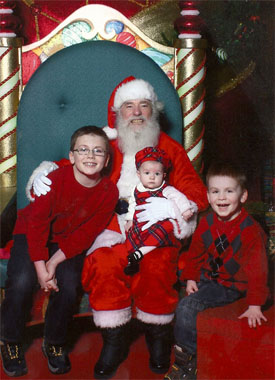
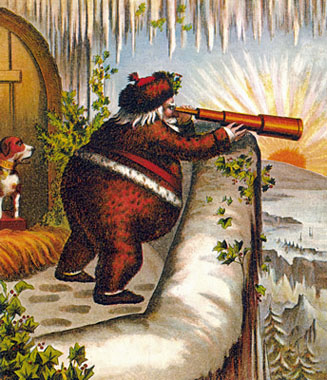

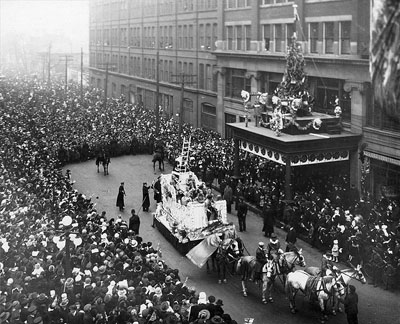

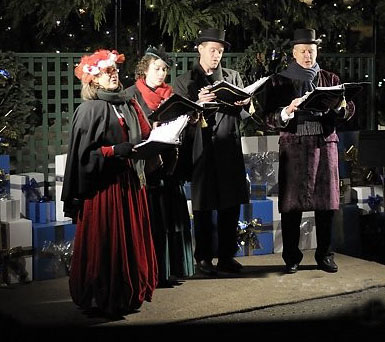

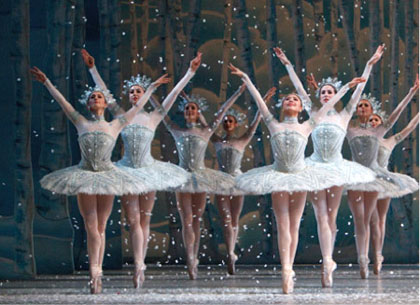


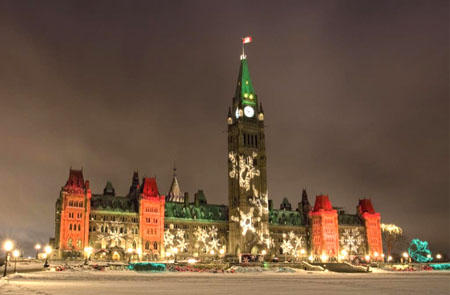
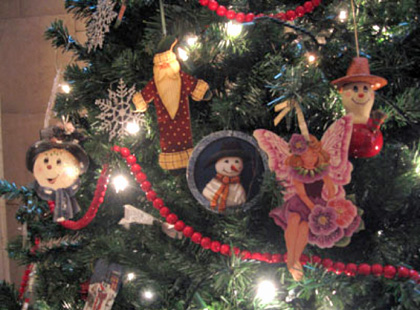











No comments:
Post a Comment
Note: Only a member of this blog may post a comment.